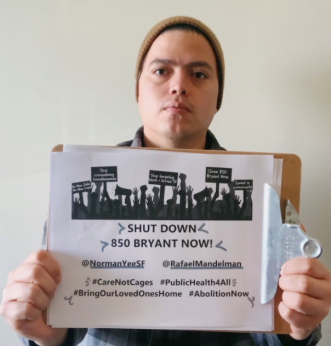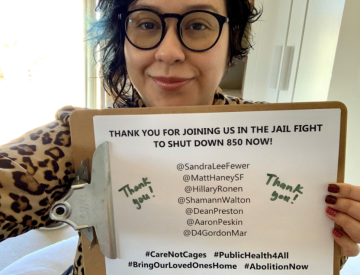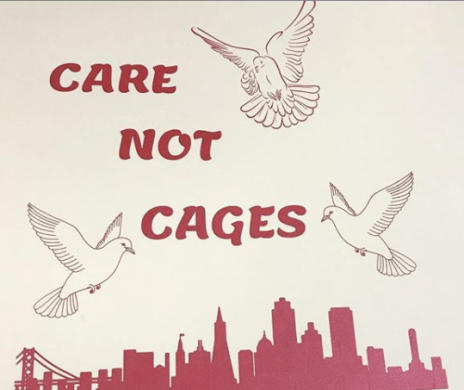Fewer’s Ordinance 2020: People’s Summary
A PEOPLE’s VICTORY: 850 BRYANT ST JAIL SHUTTERS ITS DOORS

After NoNewSFJails organized over 45 local organizations to sign our letter urging the SF Board of Supervisors to take urgent action in immediately beginning to decarcerate the city’s entire jail system as a public health measure in fighting the spread of COVID-19, Supervisor Sandra Lee Fewer heard our call and began working with our legislative team to craft a plan to close 850 Bryant Permanently.
At its introduction, the ordinance was assigned to the Government Audit & Oversight Committee (GAO), where it will undergo committee review and public comment on Thursday April 30, 2020.
People’s Summary of Fewer’s Ordinance
It’s official: County Jail 4 in 850 Bryant St has closed its doors! There are no people being imprisoned there, and we have officially shut it down.
On Wednesday, September 23, 2020, at the SF Sentencing Commission’s Safety & Justice Challenge Subcommittee meeting, city leaders including representatives of the SF District Attorney and the SF Public Defender released the first draft of the subcommittee’s “Final Report” on the successful completion of the operational plan to close County Jail 4.
The problem
The problem County Jail 4 (CJ4), located at 850 Bryant, is a dilapidated and earthquake unsafe building that has been slated for demolition since 1996. The city agrees that CJ4 must be closed, but despite the two decades that have passed since the building was condemned, CJ4 remains open today. Closing the jail is important for the health and safety of the people being held there, as well as those who work there. Most importantly, closing this vestige of the past will present an opportunity to shift city resources in a way that will actually make our communities safer without criminalizing the city’s poor and people of color.
The ordinance
This ordinance is based on a No New SF Jail Coalition proposal that was previously drafted with input from coalition member-organizations and other impacted partners. If passed, the ordinance will require San Francisco to keep the number of people in cages within the county below 1044 people. Under the ordinance, the city cannot achieve this number by transferring people out-of-county or by increasing the number of people on electronic monitoring surveillance. The ordinance will then require the county to close the decrepit and earthquake-unsafe CJ4 by November 1, 2020.
In addition to requiring the long-delayed closure of CJ4, this ordinance prohibits the city from building a new jail.
Who is introducing the ordinance?
The ordinance is being introduced by Supervisor Sandra Lee Fewer. Current co-sponsors include Supervisors Hillary Ronen, Matt Haney, and Shamann Walton. Supervisors Dean Preston, Gordon Mar, and Aaron Peskin have signaled support for the legislation. The ordinance was announced March 24; the legislation was introduced on Tuesday, April 14.

What can we do to ensure this ordinance passes?
Our Board of Supervisors and other elected officials need to know that closing CJ4 and halting the caging of human beings is a priority for their constituents and communities. We would like to make sure that the ordinance has at least an 8-Supervisor majority, which will prevent Mayor London Breed from potentially vetoing it. This will require Coalition partners and allies to show their support for the ordinance calling or visiting supervisors, mobilizing members to attend any press conferences and hearings, and using social media to reach out to our Supervisors and bring visibility to the ordinance after it is introduced.

What about community investment and alternatives to jail?
This ordinance does not require the city to invest in community resources or alternatives to jail. However, our Coalition will continue to seek those investments through the budget process and further legislation. We are proposing specific and general community and jail-alternative investments based on the savings from closing CJ4 ($25M+/yr).
4/29 Amendments to the Ordinance, as referenced in 4/30 GAO Committee Hearing:
Revisions to some language of the ordinance
- change “jail inmates”, and “offenders”, to “incarcerated individuals”
- adds intent language, in the findings, “to avoid layoffs or job loss of” employees from CJ4
And some changes to the process and terms of closure
- The new Safety & Justice Challenge Subcommittee to consider including:
- develop a new public safety release mechanism as an alternative to the PSA to conduct more thorough reviews of denied releases
- instead of discontinuing federal safekeeping arrangements, merely explore discontinuing federal safekeeping
- formulate a plan for what happens if population later exceeds 1044 after closing CJ4
- develop recommendations for temporary housing facilities if population exceeds what Director of Jail Health Services is safe for infectious disease (the legislation says “temporary housing facilities”, which is broader and could hypothetically include hotels, apartments, Tipping Point supportive housing, etc.)
- The legislation previously prohibited “measures or strategies that add new jail beds beyond the current rated capacity of County Jails 2 and 5 through construction, renovation, or reopening of another facility to replace County Jail 4” but now merely prohibits “measures or strategies that add new jail beds beyond the current rated capacity of County Jails 2 and 5 through construction, renovation, or reopening of another facility to replace County Jail 4, with the exception of measures or strategies to rehabilitate an existing facility like County Jail 2.” This amendment NNSFJ accepted with the intent to clarify that Sheriff/DPW can continue to renovate CJ2’s kitchen (which was already funded but hasn’t happened yet).
What this ordinance mean for people and communities concerned with closing 850 Bryant?
- We must shut down 850 Bryant as soon as possible— it is earthquake unsafe, known to be unsanitary, and is hazardous for every single person forced to be there.
- While the current administrative exit from the Hall of Justice (which includes CJ4) is July 2021, we simply cannot wait that long to close the jail given the conditions there, made more urgent by COVID-19.
- The conditions at 850 Bryant violate the dignity of everyone sent there and we have a moral obligation to close it as soon as possible. Even worse, keeping 850 Bryant open is costly and spends funds that could otherwise be spent on community resources and solutions.
- The COVID-19 crisis has made the closure of 850 Bryant even more urgent— people should not be placed into a potential hot zone for COVID-19 simply because they could not afford to pay their bail.
- We must prioritize closing 850 Bryant. Allowing people to go home while they await trial is the safest and easiest way to ensure that people are not unnecessarily placed at risk of COVID-19 infection.
- Closing 850 Bryant is a crucial first step to divesting from carceral policies that punish the poor, the houseless, immigrants, and people of color.
- Closing 850 Bryant will save SF an estimated $25 million/year, which is better spent on community resources that actually help people: housing, healthcare, access to healthy food, and mental health/substance use treatment.
- We need this ordinance to ensure that closing 850 Bryant doesn’t mean sending people to the extremely unsafe Santa Rita Jail in Alameda County.
- Everyone agrees 850 Bryant must close. We need this ordinance to ensure that SF uses this opportunity to move away from failed policies that put people in cages.
- With the jail population currently below 900, the City is already 200 people below the targeted number this legislation requires to decrease. This means we can #ShutDown850 TODAY!